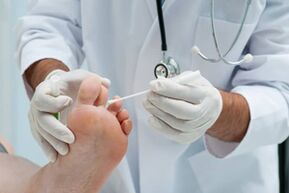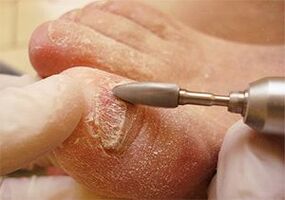After visiting a swimming pool or relaxing on the beach, you may encounter onychomycosis (fungus).
Symptoms of this disease are as follows: redness, itching and discomfort between the toes, yellowness and splitting of the nails.
The problem is quite common and does not go away on its own. If you do not consult a doctor, the fungus will develop, which can harm your body. From the article you will learn what to do in such a situation and which specialist to contact with this problem.

What should you do if you find out that you have mycosis?
If you notice one of the signs of fungus, for example, your toenails have changed color -Contact your doctor quickly!Do not allow the process of mycosis to progress so that you do not have to deal with treatment for years. Fungal spores, when released into human blood, cause a toxic reaction.
With this problemYou should first consult a dermatologist, such a specialist is available in a clinic, in a hospital, in any paid medical institution, and in a skin and venous dispensary (you can go there for free).
Which specialist should I contact, who does this?
Nail and foot fungus is a skin disease, andA dermatologist deals with such problems. You will find him in the district clinic, he conducts the first appointment, examines the patient, diagnoses onychomycosis and prescribes the necessary treatment.
If the disease is advanced or the doctor considers your case to be complex, the dermatologist will refer you to a mycologist (this specialist deals more deeply with the treatment of fungal diseases). The difficulty of contacting such a doctor is that a specialist in this field cannot always be found in a simple clinic.
Price issue
Mycologist services in public and private clinics are mainly paid. The consultation price may vary depending on the following indicators:
- area of the affected area;
- severity of the disease;
- number of required laboratory tests;
- doctor's qualifications.
The most expensive would be a consultation with a mycologist with a doctorate, and the cheapest would be a consultation with a doctor of the lowest category. Private clinics charge for each test and prescription of an individual treatment plan.
How is an appointment with a mycologist?

At the first visit to the doctor, the patient is interviewed to identify specific complaints about the skin and nails.
The mycologist will also ask questions about your lifestyle and perform an initial examination of the affected areas. But it is impossible to visually determine the type of fungus, so scraping of dead scales from the skin and nails is carried out.
All samples are sent for laboratory analysis. The materials are examined under a microscope, and some of them are placed in a nutrient medium. The analysis, which will determine the exact presence of mushrooms, takes only 3-5 minutes. And to identify a specific type of fungus it will take up to 2 weeks.
At the next appointment, the mycologist prescribes treatment, drugs are prescribed taking into account the tests performed and the patient’s condition as a whole.
Further visits to a mycologist are needed to monitor the healing process, sometimes this takes a lot of time. The disease may subside in one area of the skin and worsen in another.
The difference between a mycologist and a dermatologist
Specialist in all kinds ofskin problems – dermatologist.It is used for viral and infectious skin lesions, rashes, eczema, inflammation of the sweat glands, dermatitis and fungal skin diseases.
The first examination is carried out by a dermatologist; he can prescribe treatment himself or refer you to a mycologist.A mycologist is also a dermatologist who deals in depth with the treatment of skin, hair and nails due to fungal infections. But such a doctor cannot always be found in a clinic, and not every city has one.
What tests are prescribed?
- scraping the skin in the foot area and between the toes;
- analysis of the infected nail plate (its fragment);
- blood tests for allergens and antibodies to mycosis.
Important!
If the studies described above do not bring the desired results, histology is performed to ensure that the patient does not have fungus. In this case, consider the option of damaging the nails mechanically.
External signs of fungus sometimes coincide with signs of other nail damage. Therefore, laboratory tests must show whether a fungal infection is present. Calluses on the nail plate, bruises, changes in the color and shape of the nail may have nothing to do with mycosis.
How is the treatment carried out?

The treatment methods that were used before are no longer effective today, because the drugs do not completely cope with microorganisms. Doctors select special treatment complexes.
There is no one drug that will cure fungus, you need to combine 2 or 3 products. Creams, tablets, solutions, vitamins, droppers, special varnishes and products that dissolve the nail for subsequent removal are widely used in medicine.
Important!
Drugs for the treatment of fungus have a large number of side effects; self-medication should not be allowed! The lesion may move to another location, and the disease may become more advanced. Be sure to see a specialist in order to cope with the disease as quickly and safely as possible.
Systemic therapy
Mycologists prescribe systemic treatment to their patients in order to achieve a faster recovery.
What can be prescribed to a patient with mycosis? Systemic therapy includes the following measures:
- Oral medications (tablets).
- Local preparations (in the form of creams, ointments, etc. )
- Removal of nails through surgery.
Removing the nail plate
The nail can be removed in several ways: surgically and using special means.

Non-surgical removal method does not cause pain, and you won't have to worry about visiting a surgeon. A few days - and a new, uninfected nail will begin to grow.
If obvious symptoms disappear, then the treatment is considered complete, but you need to make sure of this by taking repeated tests, twice.
Tests are taken once at the end of the course of treatment, and again after a month from the date of recovery of the patient.
The mycologist must not only prescribe a course of treatment, but also monitor how it progresses and what results it brings. Even after complete recovery, you need to visit a doctor and take preventive measures to avoid relapses.
Laser treatment

Laser treatment is a type of physical therapy. Exposure to a laser beam is not used as a separate method of treatment.
For maximum positive effectlaser therapy is combined with other drugs. It improves blood circulation and has a beneficial effect on the nutrition of the nail plate.
Thus, antimycotic drugs penetrate deeper into the infected area. But it is impossible to kill the infection with laser alone. However, there are no contraindications to the procedure; it reduces the likelihood of re-infection. This is a painless and completely safe method of treating a disease such as onychomycosis.
Therapeutic pedicure

Therapeutic pedicure for mycosis of the nails is performed with the aim of having a healing effect on the nails and skin of the feet.
This procedure prevents the development of the disease and the further spread of fungal spores.During the pedicure, the affected areas of the skin of the feet and nails are removed..
Therapeutic pedicure is especially important for patients who:
- often experience ingrown nails;
- have a lot of calluses on their feet, corns, warts on their feet;
- have a thin and weak nail plate.
The main goal of the procedure is disinfection. Therapeutic pedicure helps remove yellowness, unevenness and bumps from the nails. Before applying varnish, be sure to ask your doctor if this is acceptable.
Important!
Be careful and careful when choosing a specialist. Make sure that you are qualified and that your pedicure tools are properly processed.
Prevention of mycosis on the legs
To avoid such an unpleasant disease, you just need to be careful and periodically do fungal prevention. A trip to the beach, pool, gym, or bathhouse can result in big problems. The fact is that fungal pathogens are very resistant to external influences. Fungal spores tolerate heating, drying, and freezing.
There are several main causes of infection. Follow the rules below to avoid illness:
- do not walk on the beach without shoes;
- in the bathhouse and sauna, be sure to use closed rubber shoes that protect against splashes;
- after bathing, dry your feet thoroughly, paying special attention to the folds between the toes, also use powder or a special antifungal cream;
- do not use someone else's shoes;
- Wear clean stockings or socks every day.
Conclusion
When the immune system is strong and functioning normally, mycosis on the legs will not harm the body even after infection, thanks to the protective abilities of the immune system. If the fungus begins to spread on the nails, you need to contact a dermatologist or mycologist as soon as possible, who will prescribe the optimal treatment regimen.
















